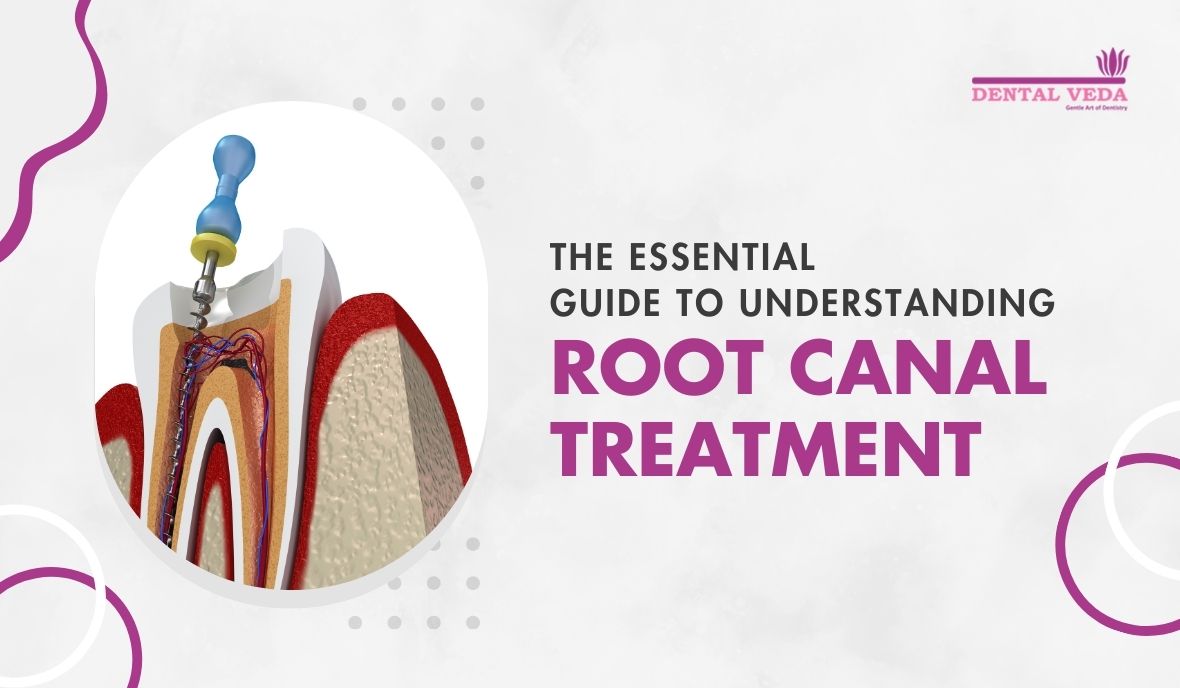Root Canal Treatment (RCT) often shrouds itself in an air of mystery and fear, invoking anxiety in many dental patients. The mere mention of it can send shivers down the spine.
The fear associated with RCT is largely rooted in misconceptions and lack of understanding. In this comprehensive guide, we will delve into the intricacies of root canal treatment, from the basics of tooth anatomy to the aftercare and recovery process.
What is a Root Canal?
To understand RCT, it is important to understand the structure of a tooth. Each tooth contains a pulp chamber, which houses the dental pulp—a soft tissue consisting of nerves, blood vessels, and connective tissue. When this pulp becomes infected or inflamed due to severe decay, cracks, or trauma, a root canal becomes necessary.
The dental pulp, once vital for tooth development, can be removed during RCT without affecting the tooth function. The procedure involves cleaning and disinfecting the root canal system, subsequently filling and sealing it to prevent further infection.
How to Know If You Need a Root Canal?
Determining whether you need a root canal involves recognizing signs and symptoms that indicate potential issues with the dental pulp. Here a closer look at how to identify if you might need a root canal:
- Persistent Toothache:
- Sensitivity to Hot or Cold:
- Swelled and Tender Gums:
- Discoloration of the Tooth:
- Prolonged Pain After Dental Procedures:
- Through X-ray Findings:
One of the most common indicators is a lingering, throbbing toothache. If you experience continuous discomfort, especially when biting down or applying pressure to the affected tooth, it could be a sign of pulp inflammation or infection.
Heightened sensitivity to hot or cold temperatures that lingers even after the temperature stimulus is removed may indicate problems with the dental pulp. If sipping hot coffee or indulging in a cold treat triggers sharp, lasting pain, its time to consult a dentist.
Inflammation and tenderness in the gums surrounding a specific tooth may signal an infection. Swelling could be accompanied by a pimple-like bump on the gum, known as a dental abscess, which requires immediate attention.
A tooth that has undergone changes in color, appearing dark or grayish, may indicate issues with the pulp. This discoloration is a result of the death of the pulp tissue and requires prompt evaluation by a dental professional.
If you have recently undergone dental treatment, such as a filling or crown placement, and experience persistent pain that doesnt subside with time, it could signal underlying issues with the tooth pulp.
X-rays can help reveal abnormalities in the tooth roots and surrounding structures. Dentists can identify signs of infection or inflammation in the dental pulp through these images.
Root Canal Procedure
The root canal treatment procedure involves multiple steps, each carefully designed to alleviate pain, eliminate infection, and preserve the natural tooth. Understanding the process can help demystify the treatment and ease any apprehensions. Here is an in-depth look at the key stages of the root canal procedure:
- Initial Assessment:
- Local Anesthesia:
- Access Opening:
- Removal of Infected Pulp:
- Cleaning and Disinfection:
- Filling the Canals:
- Temporary or Permanent Restoration:
- Follow-Up Appointments:
The treatment journey begins with a comprehensive dental examination. The dentist assesses the tooth condition through clinical evaluation and, if necessary, X-rays. This initial step is crucial in determining the extent of damage and whether a root canal is indeed required.
Prior to treatment, the dentist ensures your comfort by administering local anesthesia to numb the affected tooth and the surrounding area. Contrary to popular belief, modern anesthetics make the process relatively painless.
Once the area is numb, the dentist creates a small access opening in the tooth crown. This allows direct access to the pulp chamber and root canals, the focal points of the procedure.
The dentist carefully removes the infected or damaged pulp from the pulp chamber and root canals. Specialized tools, including tiny files and irrigating solutions, are employed to clean and shape the canals, ensuring the removal of all infected tissue.
Thorough cleaning and disinfection of the root canal system are paramount to eliminate bacteria and prevent future infections. Advanced techniques, such as rotary instruments and irrigation, enhance the precision and effectiveness of this step.
After cleaning and disinfecting the canals, they are then filled with a biocompatible material called gutta-percha. This material seals the canals, preventing the entry of bacteria and other contaminants. The access opening is sealed temporarily to protect the tooth during the healing phase.
Depending on the complexity of the case, a temporary or permanent restoration may be placed over the access opening. In many instances, a dental crown is recommended to provide long-term protection, strength, and aesthetics to the treated tooth.
The root canal procedure may span one or more appointments, depending on factors such as the tooth location and the severity of the infection. Follow-up appointments are scheduled to monitor the healing process and, if necessary, complete the restoration with a permanent crown.
Choosing the Right Dentist
Selecting the right dentist is a critical step in ensuring a successful and comfortable root canal experience. Here a guide on factors to consider when choosing the right dentist for your root canal treatment:
- Specialization and Expertise
Look for a dentist with expertise in endodontics, the specialized branch of dentistry that focuses on the diagnosis and treatment of dental pulp and root canal issues. Endodontists undergo additional training beyond dental school, making them well-equipped to handle complex root canal procedures.
- Recommendations and Referrals
Seek recommendations from friends, family, or colleagues who have undergone successful root canal treatments. Referrals can provide valuable insights into the skills, professionalism, and patient care of a dentist.
- Professional Credentials
Verify the dentist credentials, including their education, training, and any relevant certifications. Check if they are a member of professional organizations, such as the American Association of Endodontists, which can be indicative of their commitment to staying updated on the latest advancements in their field.
- Technology and Equipment
A modern dental practice equipped with advanced technology can contribute to a more efficient and comfortable experience. Look for a dentist who utilizes digital imaging, rotary instruments, and other cutting-edge equipment for accurate diagnostics and treatment.
- Patient Reviews and Testimonials
Online reviews and testimonials from previous patients offer valuable insights into the dentist reputation and the quality of care they provide. Pay attention to reviews that specifically mention root canal treatments to gauge the dentist proficiency in this area.
- Accessibility and Location
Consider the location and accessibility of the dental practice. A conveniently located office with flexible hours can make it easier to schedule appointments and adhere to the recommended follow-up visits.
Myths and Facts about Root Canal Treatment
The root canal procedure is surrounded by a myriad of myths that often contribute to anxiety and fear. Let us debunk some common misconceptions and uncover the facts about root canal treatment:
Myth: Root Canal Treatment is Painful
Fact: One of the most prevalent myths is that root canal treatment is an excruciatingly painful procedure. In reality, advancements in dental techniques and anesthesia have made the process relatively painless. Patients often report feeling only mild discomfort during the recovery phase, which can easily be managed with over-the-counter pain relievers.
Myth: Root Canals Remove the Sensation of Tooth
Fact: Root canal treatment aims to alleviate pain and save a tooth by removing the infected or inflamed pulp. However, the tooth structural integrity and basic functionality are preserved. After the procedure, a dental crown is often recommended to restore strength and aesthetics.
Myth: Extraction is Better Than Root Canal Treatment
Fact: Saving a natural tooth through root canal treatment is generally preferable to extraction. Natural teeth are crucial for maintaining oral health, proper chewing, and preventing adjacent teeth from shifting. Dental implants or bridges, which replace extracted teeth, come with their own set of challenges and may be more invasive and costly.
Myth: Root Canal Treatment Causes Illness
Fact: This myth originated in the early 20th century but has been thoroughly debunked. There is no scientific evidence supporting the notion that root canal-treated teeth contribute to systemic illnesses. Root canal procedures are safe and effective, with a high success rate.
Myth: You Only Need a Root Canal if You Feel Pain
Fact: Pain is a common symptom, but not everyone experiencing dental issues necessitates root canal treatment. Some infections or inflammations may be asymptomatic initially. Regular dental check-ups, including X-rays, help identify problems before they become painful, allowing for early intervention.
Myth: Root Canals Take Several Appointments
Fact: While the number of appointments can vary depending on the case complexity, many root canal treatments are completed in one or two visits. Technological advancements and modern techniques have significantly reduced the time required for the procedure.
Conclusion
Root canal procedure, often misunderstood and surrounded by unfounded fears, is an endodontic procedure used to save severely damaged or infected teeth. The procedure involves removing the infected or damaged pulp, cleaning and disinfecting the canal, and sealing the tooth. The procedure can help in keeping the the natural tooth and avoiding extraction.
While the procedure may seem daunting, modern advancements in dental technology and techniques have transformed root canal treatments into more efficient, comfortable, and less intimidating experiences.
Experience painless and advanced dental care at Dental Veda, top dental clinic in Gurgaon. Discover the latest in technology with Laser Root Canal Treatment in Sushant Lok. Trust us for a comfortable and anxiety-free dental experience. Schedule your appointment today for painless root canal treatment in Sushant Lok.


